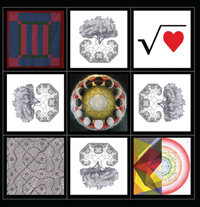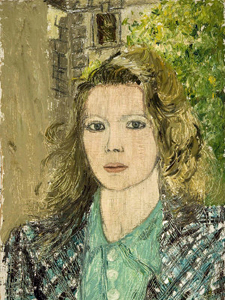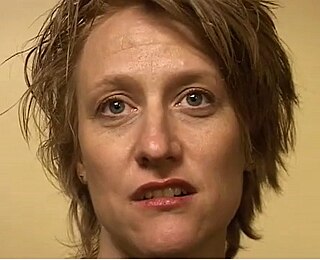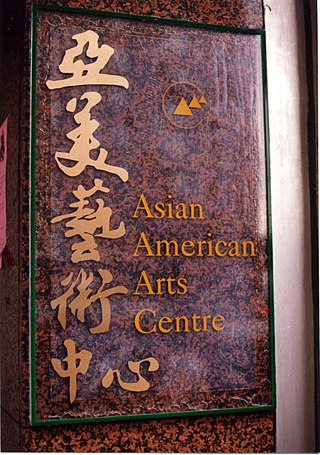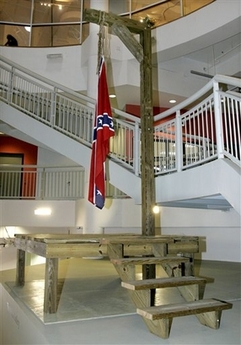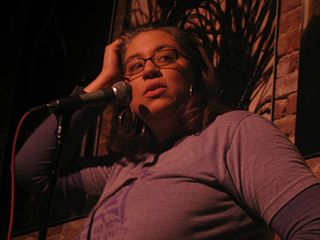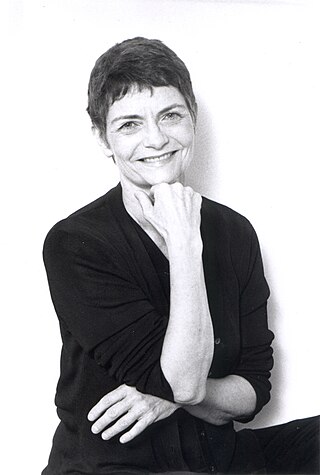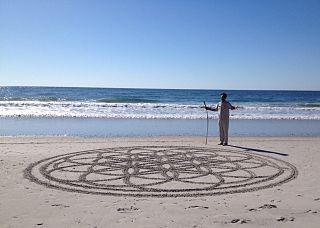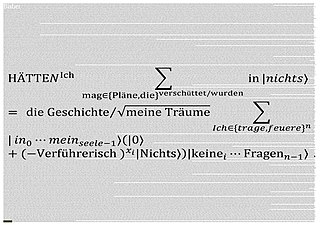Rhythm of Structure: Mathematics, Art and Poetic Reflection at Bowery Poetry Club (2009-10)
Mathematics, Art and Poetic Reflection, 2009-2010, premiered at the Bowery Poetry Club in New York City, New York. [8] [26] [27] This exhibition consisted of nine shows, each show a month long typically featuring two artists or a small group. Featured poets or performers were invited to respond to the works with a performance at the closing of the show. [28] The entire exhibition featured over 70 artists and performers, plus an art class from Brooklyn Academy of Science and the Environment, and students of the Rhythm of Structure Class at NYU Tisch School of the Arts. The complete exhibition led to a published catalog and documentary film, which screened at the Sarasota Film Festival in 2012. The entire exhibition then traveled as a summary show to Ringling College of Art and Design, as well as Antioch College in 2011. [29] [26]
Squares and Circles featuring John Hiigli and Vandorn Hinnant
This inaugural show featured the duet paintings: Chrome 163 by John Hiigli, and What Euclid intended for us to know by Vandorn Hinnant. Responding poems/poets: Circular Vibration by Christina Schmitt, The Digital Organic by Alan Gilbert, The Square Transformed by Christina Schmitt, and Poemedy Squircular (Excerpt) by Summer Hill Seven. [27]
Lines and Curves featuring Paulus Gerdes/John Sims and Ken Hiratsuka
This show featured rope installation and stone carving: A Roped Mirrored Curve by Paulus Gerdes/John Sims, Chained Universe by Ken Hiratsuka. Responding poems/poets: Quadrants by Kristin Prevallet, Images of Devonian Age by Pooh Kaye, and The Curvature of Green by Shanxing Wang. [27]
The Cartesian MathArt Hive featuring The Hive Artists
The Cartesian MathArt Hive created by John Sims based on the rotations of his piece SquareRoots of a Tree in a collaboration of the following works: Haloed Angel Study: Spark by Dorothea Rockburne, Eseau on Globe Crossing by Joyce Wellman, Chrome 151: 3 Spheres by John Hiigli , Isometric Systems in Isotropic Space-Map Projection: The Cube by Agnes Denes, Square Roots of a Tree by John Sims, Squaring the Circle: Heaven in Earth by Pam Tuczyn, Drawing 13 by Roman Verostko, Poincare-double lace by Carlo Sequin, Iterations by Mike Field, Enlightened Vision #10 by Christina Schmitt, Kelien-Fountain by Davide Cevone, Root Three Fractal SpiralGram by Vandorn Hinnant, Zero by Kevin Dean, Tree Root of a Fractal by John Sims, Spheres by Susan Happersett, Fish by Ken Hiratsuka, Drawn with a Compass, Chopstick and a Pen by Howardena Pindell, Our Days are Numbered! by Robert Fitterman, Mapping of the Universe by Faybiene Miranda, Is Numerology Math by Chris Funkhouser, Where Come Together by Chris Funkhouser, Alphabetical Mutability by Tatiana Bonch, and One by Marcella Durand. [27]
The Cartesian MathArt Hive was also featured in a Journal of Mathematics and Arts paper. [30]
You Lie featuring Paul D. Miller and Dread Scott
This exhibition featured the digital works on paper, You Lie by Paul D. Miller and Poll Dance by Dread Scott. Responding Poems/Poets: Spam A Lot (Viagra for Joe Wilson) by LaTasha N. Nevada Diggs, Survey by LaTasha N. Nevada Diggs, Coolant System by Alan Gilbert, and Count Me In by Kelly Zen-Yie Tsai. [27]
The Square Root of Love featuring Karen Finley and John Sims
This duet show featured: Many Moods of Love by Karen Finley and Square Root of Love by John Sims. Responding Poems/Poets:The Square Root of Love: Calculating the HEART of Things by JoAnne Growney, and Learning To Be My Father's Son or 16 Things I Could Never Tell My Father by Regie Cabico. [27] [31]
John Sims' part of exhibition developed into a Valentine's Day wine-poetry-film project premiering in Paris in 2017. [32]
Selected Infinite Extensions Arbitrarily Constrained featuring Sol LeWitt and Adrian Piper
Selected Infinite Extensions Arbitrarily Constrained featuring Sol LeWitt and Adrian Piper was a duet show that featured the wall installations: Drawing #163 by Sol LeWitt, and Vanishing Point #1 by Adrian Piper. Responding Poems/Poets: Sociedad Anonima by Mónica de la Torre, Two Poems Squared by Bob Holman, Dear Morning Light dear visiwind by Bob Holman, Terra Quad by Edwin Torres, MathArtPoem: A LeWitt/Piper Response by John Sims/Rhythm of Structure Class/NYU, For the Girl Who Was Asked to Write a Poem About Me and, as Usual, Wanted to Write a Poem About Her Heart Instead by Eboni Hogan, The Elevator by Mark Strand, and Empty by Jon Sands. [27]
Selected Infinite Extensions Arbitrarily Constrained was reviewed by Art in America Magazine. [33]
(20, 21, 29): An Assignment featuring the Students of Brooklyn Academy of Science and Environment
(20, 21, 29): An Assignment, a visualization of the Pythagorean triple (20, 21, 29) created by art students with teacher Jennifer Lemish at the Brooklyn Academy of Science and the Environment. [34] Responding Poems/Poets: 21 Reasons Why I hate Math by Shappy Seasholtz, and 29 Solutions For Writers, by People Who Know Better Than Me by Cristin O'Keefe Aptowicz. [27]
Mathematical Graffiti featuring Fernando Mora, John Sims with Kyle Goen, Mark Turgeon, and the Bowery Poetry Club Patrons
Mathematical Graffiti featured: Fernando Mora, John Sims with Kyle Goen, Mark Turgeon, and the Bowery Poetry Club Patrons. Poetic Responses: Mutually Inverse Operations: Mathematical Poetry on the Occasion of the Mathematical Graffiti Wall by Gregory Vincent St. Thomasino, Proportional Poems by Kaz Maslanka, Graffiti Mathemaku by Bob Grumman, 33 Symmetry Axes x 40 Orthogonal Triples: or, Free Will, Revisited by Stephanie Strickland, Who Counts, Counts by Stephanie Strickland, and Notes on Numbers by Richard Kostelanetz. [27]
Gregory Vincent St. Thomasino featured portions of this exhibition in his blog. [35]
The HyperQuilt featuring Helen Beamish, Elaine Ellison, Suzanne Gould, John Sims, Ella Toy, Diana Venters, and Paula Wynter
The HyperQuilt featured: Helen Beamish, Elaine Ellison, Suzanne Gould, John Sims, Ella Toy, Diana Venters, and Paula Wynter. Responding Poems/Poets: The Language of Quilts by Tara Betts, The Last Time by Adam Falkner and Jeanann Verlee, We Come From Farm People by Kate Rushin, The Math Poem: Along The Learning Curve by Kate Rushin. [27]
Rhythm of Structure: Bowery and Beyond (2011)
The entire nine Rhythm of Structure shows at the Bowery Poetry Club were brought together as one united Rhythm of Structure: Bowery and Beyond exhibition at the Selby Gallery at Ringling College of Art and Design in February, 2011. [36] [37]
After the Selby Gallery showing at Ringling, it was shown later that year at the Antioch College, from May to November 2011. [38] [39] [40] [41] The Dayton City Paper reviewed the exhibition and featured an article in their local newspaper. [42]
